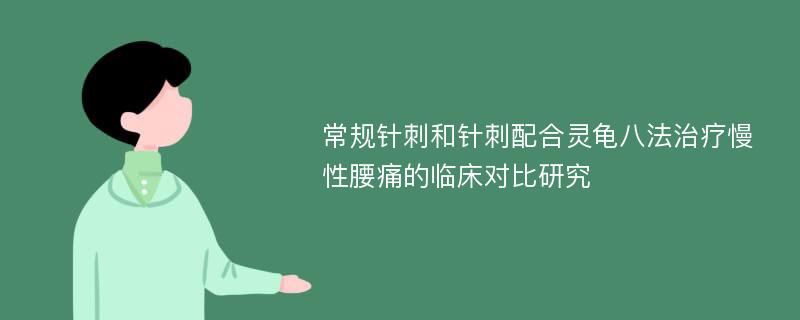
论文摘要
背景:慢性腰痛是一种常见的疾病,是造成误工的最主要因素。目前,越来越多的医生和患者倾向于运用针灸治疗该病。研究方法:该研究包括三部分。第一部分为临床试验,将两种不同针灸方法(单纯体针和体针配合灵龟八法)治疗慢性腰痛的疗效进行对照研究,从四个方面进行评价:1)是第一次治疗前后VAS评分的改变;2)是需要进行治疗的次数;3)是在治疗过程中和三个月的随访中患者因此病误工的天数;4)是三个月随访患者疼痛的复发率。在第二部分中,选取是否抽烟,受教育程度,年龄,性别,体重指数和是否抑郁作为研究指标,在60例慢性腰痛患者和100例无慢性腰痛患者(对照组)中进行病例对照研究。第三部分为病例调查,对60例慢性腰痛病人接受10次针灸治疗后的疗效进行调查研究。结果:在临床试验这部分中,通过降低VAS评分(p<0.001)和疗程长度(p<0.001),我们发现体针配合灵龟八法比单纯体针治疗慢性腰痛疗效要更为显著。但两种疗法在治疗过程中对于减少因病误工天数(p>0.05)无明显差异。而三个月随访,应用体针配合灵龟八法治疗患者的误工天数要明显少于另外一组(p<0.05)。两组患者在治疗结束后一个月的随访中,疼痛复发率无差异(p>0.05)。而在结束治疗三个月之后的随访中,接受体针配合灵龟八法治疗患者的疼痛复发率要明显低于另外一组(p<0.05)。作为观测指标,是否抽烟(p<0.05),年龄(p<0.05),性别(p<0.05),体重指数(p<0.001)和是否抑郁(p<0.05)与慢性腰痛的发病密切相关,但受教育程度(p>0.05)与其并无联系。针灸治疗慢性腰痛的有效率为78%(双侧t检验p<0.001)。结论:对于慢性腰痛的治疗,应用时间疗法配合常规体针疗法可以明显提高并延长疗效。
论文目录
AbstractAbstract in EnglishAbstract in ChineseChapter one- Introduction1-1 Definition1-2 Epidemiological aspects of LBP1-3 Allopathic and Chinese Medicine diagnosis and treatment of Low back pain1-4 Causes of Low Back Pain according to Western Medicine and Chinese medicine1-4-1 Western medicine causes1-4-2 Causes of low back pain according to Chinese medicine1-4-2-a Kidney Yang deficiency1-4-2-b Kidney Yin deficiency1-4-2-c Sprain of the back1-4-2-d Cold dampness in lower back1-4-2-e Blood stasis in the back1-4-2-f Invasion of wind-cold1-4-2-g Kidney Qi deficiency1-5 Why should we do this researchChapter two-Review of the literature2-1 Acupuncture for the treatment of Chronic Low Back Pain2-2 Acupuncture based on time2-2-a Introduction2-2-b Section One:Introduction to Gan-Zh2-2-c Section Two:Matching of Gan-Zhi2-2-d Section 3:Hour prescription of points2-2-e Section 4:Eightfold method of sacred tortoise2-2-f Section 5 Eightfold method for convenience(Feiteng)2-2-g New researches on time method acupuncture2-3 Low back pain tisk factors2-3-1 Age2-3-2 Smoking2-3-3 Body weight2-3-4 Depression factor2-3-5 Education2-3-6 Patient's gender2-4 Summary of literature reviewChapter three-Methods and Materials3-1 Objectives3-1-1 General objective3-1-2 Specific objective3-1-3 Questions of thesis3-1-4 Hypothesis of research3-2 Study design3-2-1 The title and kind of the research3-2-2 Location of research3-3 Outcome and variables assessment scales for all three part of research3-3-1 Pain3-3-2 Duration of treatment3-3-3 Relapse of pain3-3-4 Absenteeism factor3-3-5 Depression3-3-6 Obesity3-3-7 The educational level3-3-8 Age3-3-9 Smoking3-3-10 Gender3-4 Ethical issue3-5 Analysis the dataChapter four- Results4-1 The patients'Characteristics4-2 Statistical calculationsChapter five- Discussion5-1 Analysis of statistical5-1-1 Clinical trial part5-1-2 Case- Control part5-1-3 Case series part5-2 Confluent point mechanismChapter six- ConclusionReferencesAcknowledgementAppendix
相关论文文献
- [1].多元时间针法治腹水经验[J]. 辽宁中医杂志 2010(S1)
- [2].关节松动术配合灵龟八法治疗膝骨性关节炎40例[J]. 河南中医 2015(08)
- [3].时间针灸学理论探源[J]. 成都中医药大学学报 2015(02)
标签:时间针法论文; 灵龟八法论文; 慢性腰痛论文; 危险因素论文;
常规针刺和针刺配合灵龟八法治疗慢性腰痛的临床对比研究
下载Doc文档
